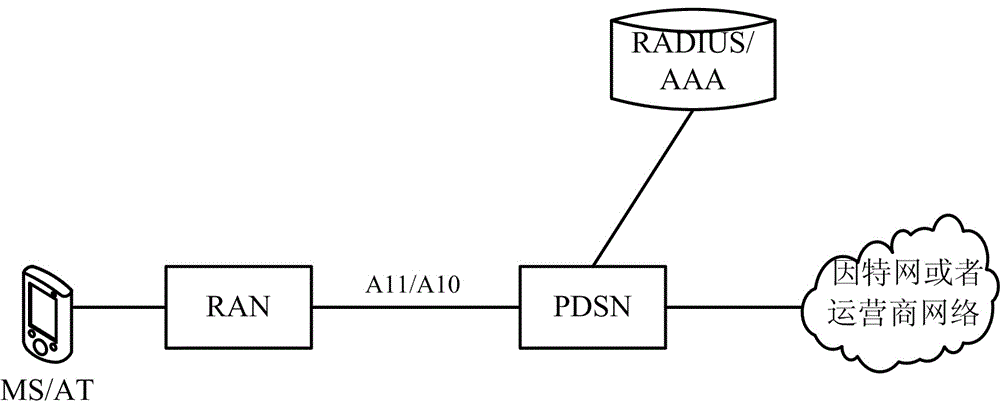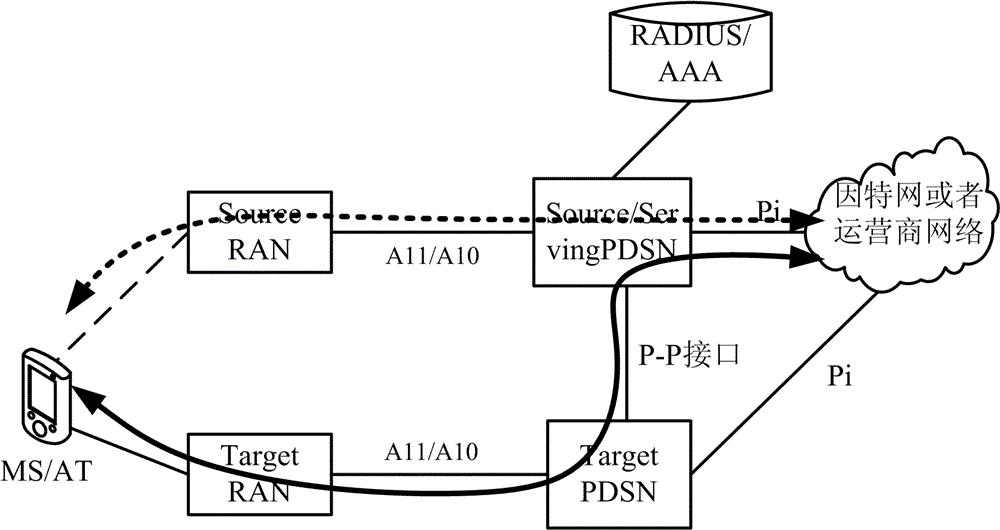A switching method and system
A target, downlink data technology, applied in wireless communication, network traffic/resource management, electrical components, etc., can solve problems such as unfavorable cost saving, blocked terminal services, waste of carrier transmission and bearer resources, etc., to reduce the possibility of network congestion performance, saving transmission bearer resources, and improving service experience
- Summary
- Abstract
- Description
- Claims
- Application Information
AI Technical Summary
Problems solved by technology
Method used
Image
Examples
Embodiment 1
[0076] In this embodiment, during the anchor point replacement process, both the S-PDSN and the T-PDSN perform the dual data transmission function to ensure uninterrupted services and data integrity.
[0077] Such as Figure 4 As shown, the main steps of this embodiment are specifically described as follows:
[0078] Steps S401-S404: Same as steps S301-S304.
[0079] After step S404, according to the existing technology, after the downlink data arrives at the S-PDSN, it will be dual-transmitted to the source side and the target side at the same time.
[0080]Step S405: the S-PDSN sends the RRP message of the P-P interface to the T-PDSN as a response to step S404.
[0081] In the response message, S-PDSN sends all information related to the terminal, such as user context, authentication context and PPP context, to T-PDSN.
[0082] In this message, the S-PDSN sends the AID to the T-PDSN; or, the T-PDSN can query the AID mapping server to obtain the AID according to the termin...
Embodiment 2
[0094] In this embodiment, only the S-PDSN performs the dual data transmission function during the anchor point replacement process to ensure data integrity. In addition to indicating the switch of the dual-transmission function, the S bit is also used to indicate the timing of T-PDSN and / or S-PDSN external announcement. For the specific implementation of the announcement, refer to the description of Embodiment 1.
[0095] Such as Figure 5 As shown, the main steps of this embodiment are specifically described as follows:
[0096] Steps S501-S504: Same as steps S301-S304.
[0097] After step S504 is completed, the downlink data will be dual-transmitted to the source side and the target side at the same time after reaching the S-PDSN according to the existing technology.
[0098] Step S505: the S-PDSN sends the RRP message of the P-P interface to the T-PDSN as a response to step S504.
[0099] In the response message, S-PDSN sends all information related to the terminal, su...
Embodiment 3
[0110] In this embodiment, during the replacement process of the anchor point, the dual transmission function is completely canceled, and all data packets received during the switching process are sent to the target side. If the link establishment of the target side has not been completed, the data packets Temporarily cache, and then send the data after the link is opened.
[0111] Such as Figure 6 As shown, the main steps of this embodiment are specifically described as follows:
[0112] Steps S601-S604: same as steps S301-S304.
[0113] After step S604 is completed, although the S-PDSN has received the S bit set to 1, the downlink data is only sent to the target side through the P-P interface after arriving at the S-PDSN, and the target side sends it to the T-RAN or T-PDSN cache.
[0114] Step S605: the S-PDSN sends the RRP message of the P-P interface to the T-PDSN as a response to step S604.
[0115] In the response message, S-PDSN sends all information related to the ...
PUM
 Login to View More
Login to View More Abstract
Description
Claims
Application Information
 Login to View More
Login to View More - R&D
- Intellectual Property
- Life Sciences
- Materials
- Tech Scout
- Unparalleled Data Quality
- Higher Quality Content
- 60% Fewer Hallucinations
Browse by: Latest US Patents, China's latest patents, Technical Efficacy Thesaurus, Application Domain, Technology Topic, Popular Technical Reports.
© 2025 PatSnap. All rights reserved.Legal|Privacy policy|Modern Slavery Act Transparency Statement|Sitemap|About US| Contact US: help@patsnap.com



